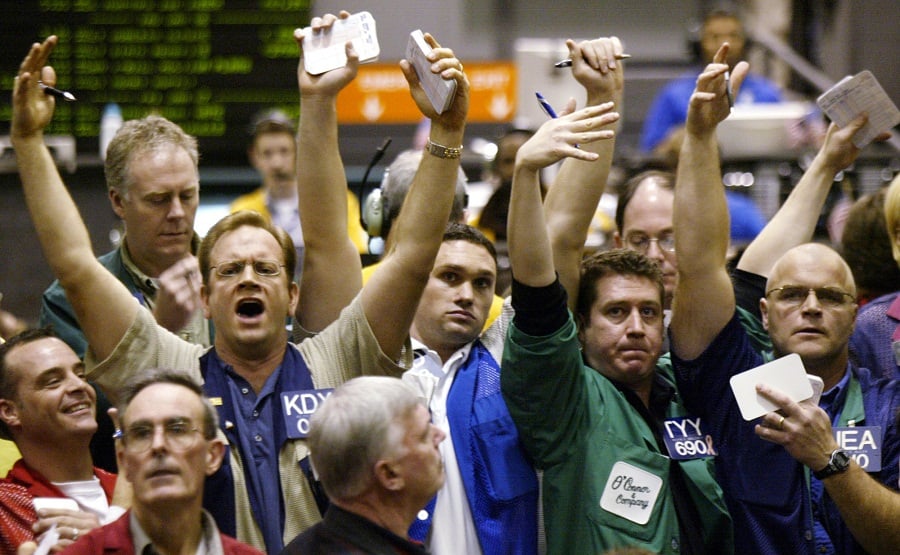Everyone is talking about how exchange-traded funds have now
overtaken hedge funds in terms of total assets.
That's small change compared with how much ETFs trade nowadays.
In the past 12 months investors traded $18.2 trillion worth of ETF shares, according to data from the New York Stock Exchange and Bloomberg. That's a 17% increase from the 12 months prior and more than triple what it was 10 years ago. For perspective, that means the amount of dollars exchanging hands through ETFs is now more than the U.S. gross domestic product, which stands at $17.4 trillion. (Sadly, both those numbers are less than the U.S.'s $18.5 trillion in debt.)
But perhaps even more astonishing than the raw amount of trading is that U.S. ETFs only have $2.1 trillion in assets. In other words, the turnover in ETFs is about 870% a year. This is more than four times the turnover for U.S. stocks, which comes in at about 200%.
LIKE A SNOWBALL ROLLING DOWNHILL
The increase in volume over the years can be attributed to both repeat customers as well as new participants who like anonymously darting in and out of everything from small-cap stocks to high-yield bonds to oil futures in an instrument that trades like a stock. Like a snowball rolling downhill, as an ETF sees volume increase it tends to attracts more, and bigger, investors, which in turn increase the volume.
All this manic trading is led by the insanely active SPDR S&P 500 ETF (SPY), which makes up a third of the total, or $6 trillion. That breaks down to about $24 billion a day, which is four times more than any other security on the planet and more than the next nine most traded equities combined. With $177 billion in assets, SPY's yearly turnover equates to a mind-boggling 3,400%.
Beyond SPY, ETFs account for three of the top four most active equities, with the iShares Russell 2000 ETF (IWM) and the Powershares QQQ Trust (QQQ) trading over $3 billion a day each. Beyond equities, another big-time contributor to the trading volume is the iShares 20+ Year Treasury Bond ETF (TLT), which trades $1.1 billion a day, or more than what Citigroup stock trades. TLT's massive volume shows just how thirsty investors are to trade bonds like stocks. (Individual bonds traditionally trade over the counter, and investors' use of ETFs to dip in and out of less liquid fixed-income assets has prompted
quite a bit of controversy in recent years.)
But it isn't just the old-timer ETFs contributing to this trading as some of the newer, more complex ETFs are also throwing down some ridiculous numbers.
31,000% A YEAR
Nothing exemplifies this more than the VelocityShares Daily Inverse VIX Short-Term ETN (XIV), which trades $830 million worth of shares a day. That's more than what blue chip stocks such as Johnson & Johnson and Wal-Mart trade. On top of that is the fact that XIV only has $675 million in assets, which means its turnover is 122 a day, or 31,000% a year. Try getting your head around that. And when you are done getting your head around that, try getting your head around the fact that XIV is up 325% in five years from shorting VIX futures.
So what is the consequence of all this trading?
Well, on one hand it is certainly good for Wall Street because it means about $9 billion in revenue from making markets based on the asset-weighted average bid/ask spread of 0.05%, which is the difference between what a market maker will buy and sell an ETF for. This is compared to the $6 billion in estimated annual revenue that ETF issuers make based on the asset-weighted expense ratio of 0.30%.
But is it good for Main Street? It depends. If retail investors can fend off the temptation to trade, then all that increased activity is — perhaps rather ironically — a good thing for them, because it brings down the round-trip cost by tightening up the bid/ask spread. This can be seen in the fact that there are now well over 200 ETFs with an average bid/ask spread of 0.03% or less. That, combined with a low fee for a product that kicks out virtually no capital-gains taxes, and you have a sweet deal.
But if individual investors can't resist the temptation to jump into the fray and trade themselves silly, then they will just be making Wall Street richer, as well as justifying John Bogle's famous claim that “an ETF is like handing an arsonist a match.”







